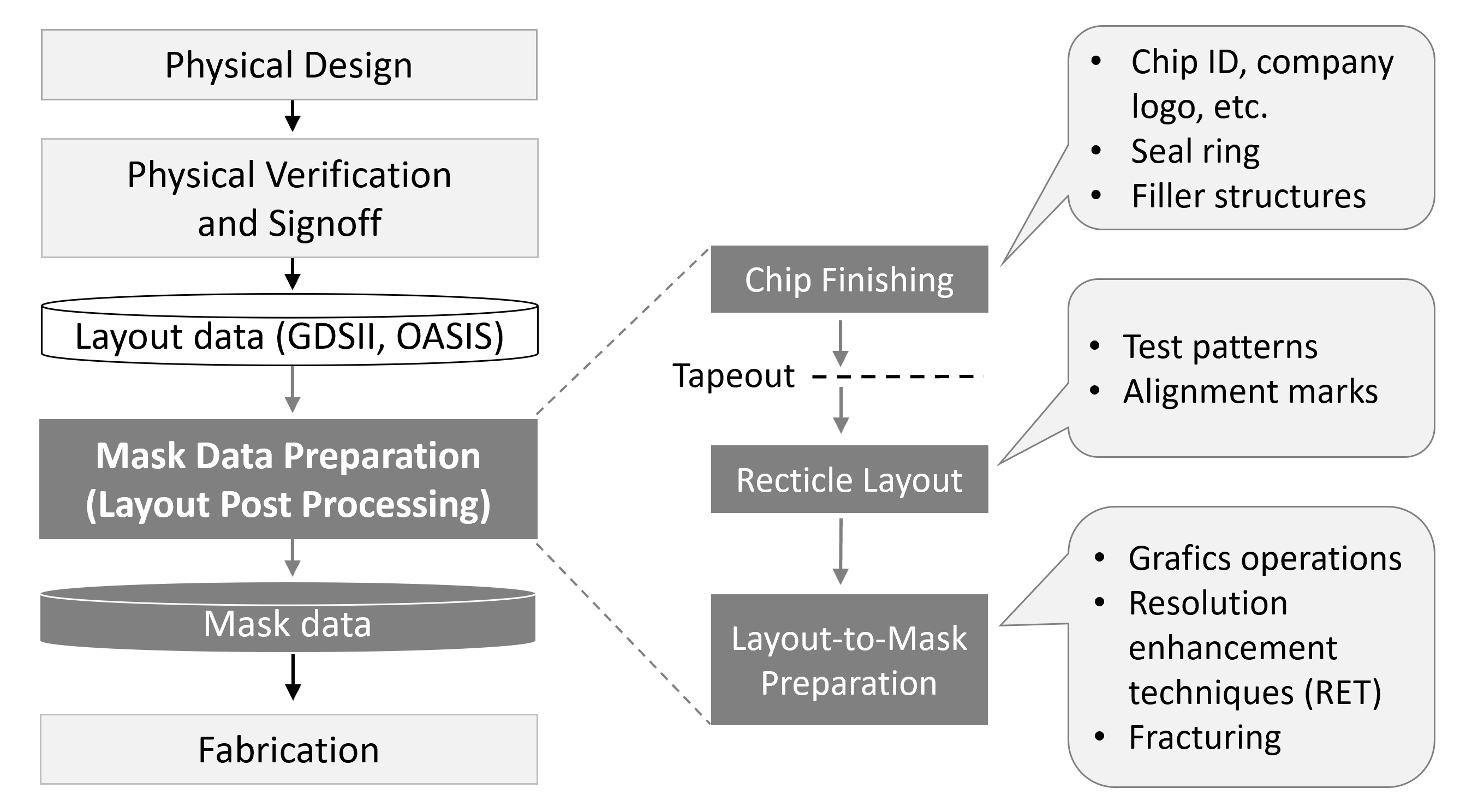Mask Data Preparation on:
[Wikipedia]
[Google]
[Amazon]
Mask data preparation (MDP), also known as layout post processing, is the procedure of translating a file containing the intended set of polygons from an integrated circuit layout into set of instructions that a photomask writer can use to generate a physical mask. Typically, amendments and additions to the chip layout are performed in order to convert the physical layout into data for mask production.
Mask data preparation requires an input file which is in a GDSII or
 Although historically converting the physical layout into data for mask production was relatively simple, more recent MDP procedures require various procedures:
* ''Chip finishing'' which includes custom designations and structures to improve manufacturability of the layout. Examples of the latter are a seal ring and filler structures.
* Producing a ''reticle layout'' with test patterns and alignment marks.
* ''Layout-to-mask preparation'' that enhances layout data with graphics operations and adjusts the data to mask production devices. This step includes resolution enhancement technologies (RET), such as optical proximity correction (OPC) or
Although historically converting the physical layout into data for mask production was relatively simple, more recent MDP procedures require various procedures:
* ''Chip finishing'' which includes custom designations and structures to improve manufacturability of the layout. Examples of the latter are a seal ring and filler structures.
* Producing a ''reticle layout'' with test patterns and alignment marks.
* ''Layout-to-mask preparation'' that enhances layout data with graphics operations and adjusts the data to mask production devices. This step includes resolution enhancement technologies (RET), such as optical proximity correction (OPC) or
OASIS
In ecology, an oasis (; ) is a fertile area of a desert or semi-desert environment'ksar''with its surrounding feeding source, the palm grove, within a relational and circulatory nomadic system.”
The location of oases has been of critical imp ...
format, and produces a file that is in a proprietary format specific to the mask writer.
MDP procedures
 Although historically converting the physical layout into data for mask production was relatively simple, more recent MDP procedures require various procedures:
* ''Chip finishing'' which includes custom designations and structures to improve manufacturability of the layout. Examples of the latter are a seal ring and filler structures.
* Producing a ''reticle layout'' with test patterns and alignment marks.
* ''Layout-to-mask preparation'' that enhances layout data with graphics operations and adjusts the data to mask production devices. This step includes resolution enhancement technologies (RET), such as optical proximity correction (OPC) or
Although historically converting the physical layout into data for mask production was relatively simple, more recent MDP procedures require various procedures:
* ''Chip finishing'' which includes custom designations and structures to improve manufacturability of the layout. Examples of the latter are a seal ring and filler structures.
* Producing a ''reticle layout'' with test patterns and alignment marks.
* ''Layout-to-mask preparation'' that enhances layout data with graphics operations and adjusts the data to mask production devices. This step includes resolution enhancement technologies (RET), such as optical proximity correction (OPC) or inverse lithography technology
In semiconductor device fabrication, the inverse lithography technology (ILT) is an approach to photomask design. This is basically an approach to solve an inverse imaging problem: to calculate the shapes of the openings in a photomask ("source") ...
(ILT).
Special considerations in each of these steps must also be made to mitigate the negative affects associated with the enormous amounts of data they can produce; too much data can sometimes become a problem for the mask writer to be able to create a mask in a reasonable amount of time.
Reticle layout
When a chip series is to be manufactured, the individual die is instantiated several times in the form of a matrix to produce what is termed the ''reticle layout''. This reticle layout consists of vertical and horizontal scribe lines that separate the individual dies that have been placed in a matrix format. The size of this matrix depends on the maximum exposable surface area based on the reticle size.Mask fracturing
MDP usually involves ''mask fracturing'' where complex polygons are translated into simpler shapes, often rectangles and trapezoids, that can be handled by the mask writing hardware. Because ''mask fracturing'' is such a common procedure within the whole MDP, the termfracture
Fracture is the separation of an object or material into two or more pieces under the action of stress. The fracture of a solid usually occurs due to the development of certain displacement discontinuity surfaces within the solid. If a displa ...
, used as a noun, is sometimes used inappropriately in place of the term ''mask data preparation''. The term fracture
Fracture is the separation of an object or material into two or more pieces under the action of stress. The fracture of a solid usually occurs due to the development of certain displacement discontinuity surfaces within the solid. If a displa ...
does however accurately describe that sub-procedure of MDP.
References
Further reading
* A survey of the field, from which this summary was partly derived, with permission. * {{Cite book, author=Lienig, J., Scheible, J., title=Fundamentals of Layout Design for Electronic Circuits, url=https://www.ifte.de/books/pd/index.html, publisher=Springer, date=2020, doi=10.1007/978-3-030-39284-0, isbn=978-3-030-39284-0, s2cid=215840278 Chapter 3.3 covers mask data generation in detail. Electronic design automation